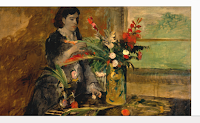By RICHARD CARREÑO
[WC News Service]
NEW ORLEANS -- What's Edgar Degas, the well-known 19th century French Impressionist, doing in this city, a place otherwise more notably recognized worldwide for its jazz, Mardi Gras, and out-of-towners publicly puking and urinating in the renowned French Quarter? For the casual admirer of Degas (1834-1917) and his iconic ouevre of ballet dancers en déshabillées, female bathers, and louche racetrack railbirds, more natural habitats would surely be the tony bits of Paris, say at the Opéra Garnier, Longchamps, and the intimate boudoirs of the gratin. For ardent and seasoned picture punters, the Musée d'Orsay would do nicely, as well.
 |
| Degas Self Portrait |
Though better known by its monikers the Big Easy and Crescent City, New Orleans is also a big chunk of 'Degas country,' thanks to a five-month family visit the artist made here in 1872. Since then, local commercial interests have milked and churned the brief sojourn into tourist fodder for more family-oriented visitors, at least those whose primary interests don't include getting drunk and getting laid.
Voilà! The house where Degas lived with relatives (and where he painted a bit as well), at 2306 Esplanade Avenue, in the leafy Mid-City precinct near the Vieux Carré, has been converted into an upscale bed-and-breakfast. And visitor site. Not far away, at 3127 Esplanade, is the Café Degas, an out-door bistro where 'nobody makes egg dishes better than [its] French chef.'
In the French Quarter itself, the artist is also remembered at another, less-well known Degas House, on Exchange Place. This property, recognized as a National Historic site, was actually owned by Degas, though he sold it in 1866, well before his one and only visit to New Orleans. Now housing law offices, the building was previously owned by his uncle Michael Musson, brother of Degas' New Orleans-born mother. (The Mussons were part of the large and affluent Creole clan). Even a lesser-known property associated with the artist, now longer extant, was a cottage in North Rampart Street in the Faubourg Marigny which Degas' father purchased to commemorate Edgar's birth.
Naturally enough, Degas memory is also celebrated by the city's principal museum, the New Orleans Museum of Art.
Well, actually not so much.
On the day of my visit, earlier this month, NOMA was displaying two Degas pieces, both small-ish statues. One was a standard-issue bronze horse; the other, a marvellous, masterful bronze of a dancer adjusting a right stocking.
A third NOMA-owned piece, an 1872 oil portrait of Estelle Musson, Degas' aunt, was away, on loan to Virginia Museum of Fine Arts.
Unfortunately, that's it. It seems that after the 1964 purchase of Musson portrait (for $200,000 in 1964 dollars), NOMA's benefactors lost heart. For all the Degas civic bluster around town, there's little otherwise to evince other aspects of his art. (The museum gift shop takes a pathetic stab at it, offering handbags featuring pictures of Degas' iconic danseuses).
Degas 'biggest' New Orleans picture is actually the 'one that got away,' a 1873 interior of the city's Cotton Market. The painting had a personal association: Edgar's brothers, René and Achille, were then working in the local cotton trade, and are indeed featured in the work. What would have been a coup for NOMA resulted in an actual loss. The Cotton Market wound up, curiously enough, in a small provincial museum in France, the Musée des Beaux-Arts in Pau, a town just north of the Spanish frontier. It's still there.
Despite the brevity of his visit, Degas' strong familial link to New Orleans engendered a life-long sentimentality about the place. He often referred to himself as 'un fils de Louisiane.' If only today's movers and shakers -- and NOMA benefactors -- felt a similar affection for Degas. At least enough to seed NOMA with one or two of his important works.

